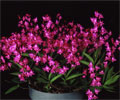|
|
|
|
|
| |
Flasks of
Dendrobium kingianum 'Betty' JC/AOS × self |
|
| |
|
|
| |
| Number: |
TN5589 |
| Name: |
Dendrobium kingianum 'Betty' JC/AOS × self
|
| Type: |
self (What's that?) |
|
Seed Donor: |
Wilford Neptune
(Email: disabled)
|
|
Click to Enlarge

Pod Parent Flowers |
Click to Enlarge

Pod Parent Blooming Plant |
Click to Enlarge

Pod Parent Flower |
Click to Enlarge

Offspring 'MC5084' Flower |
Click to Enlarge

Offspring 'MC5084' Blooming Plant |
| Offspring photos are siblings of the plants you would receive. |
|
|
|
| |
Comments: Parent plant: This individual plant has also been awarded two CCMs.
For additional origin/habitat information supplied courtesy of
Charles and Margaret Baker, see further below, near the bottom of this page.
|
Temperatures we attempt to use in the lab & greenhouse:
| For Species: |
|
Spring, Summer, Autumn: days average 75°F, nights 58°F; best fit is cool-intermediate 75-58°F
(Source:
Baker's Web OSC) |
| For Species: |
|
Winter: days average 62°F, nights 42°F; best fit is Cool-Cold 64-44°F
(Source:
Baker's Web OSC) |
|
About the name...
| Etymology of |
Dendrobium |
|
From Greek "dendron" tree and "bios" life.
(Source:
Pridgeon 1992) |
| Etymology of |
kingianum |
|
Named for Capt. P. G. King, governor of New South Wales, Australia in the 19th century.
(Source:
Mayr & Schmucker 1998) |
| Pronunciation of |
Dendrobium |
|
den-DRO-bee-um
(Source:
Pridgeon 1992) |
| Pronunciation of |
kingianum |
|
king-ee-AH-num
(Source:
Hawkes 1978) |
|
If you would like to direct someone to this web page, please copy and paste this URL into your email:
http://troymeyers.com/d?015589
| Flask Information |
| Availability: |
We have sold all of the flasks for this item. |
| You should: |
Consider getting individual plants or compots instead of a flask.
You can place a "Notify Flask Recipients" Request, and either we or a flask recipient may contact you when plants are available.
You may also place a "Notify Retries" Request, and if an identical pollination (the same parents) is done again, we'll let you know.
You may reserve a flask, but it's very unlikely you'll get one ...this could only happen if we found a flask that we didn't know we had. |
| Yield Estimate: |
540 plants (based on flask surveys done 11/14/2006 through 03/28/2007)
|
| Plantlet Sizes: |
From many flasks 10 - 60 mm plants (based on flask surveys done 03/02/2007 through 08/20/2007)
From one most recently surveyed flask 30 - 60 mm (08/20/2007)
|
|
You might also want to:
|
View the seed assay for this item.
View items of the same species.
View items of the same genus.
|
| Ordering Information |
| You are not currently logged in. |
|
You must be a registered user and be logged in to reserve a flask or place a notification request. Please log in:
|
|
|
|
|
|
| |
The origin/habitat information below is supplied courtesy of Charles and Margaret Baker
The following information is based on the name of the plant provided by the donor, and assumes that the name is correct. If the plant has been misidentified, then the following information may not be correct.
This text is copyrighted by the Bakers and may not be reproduced without permission.
ORIGIN/HABITAT: Eastern Australia. The habitat extends from the Hunter
River in New South Wales to near the Tropic of Capricorn. Plants also
occur in Carnarvon Gorge, about 280 mi. (50 km) inland at 25.0S. Plants
often grow in areas with high humidity, strong air movement, and full sun
for much of the day, but they are also found in more shaded areas. Plants
are found in pockets of leaf-mold on rocks in open forests or on cliff
faces between sea level and 3950 ft. (0-1200 m). They are usually found on
rocks but occasionally may also grow on trees.
More about this information and the Bakers...
|
|
|
| |
|
|
|